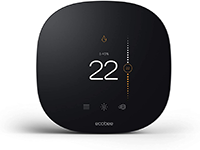The Reolink RLC-520 is an affordable indoor/outdoor security camera built to withstand harsh weather. It offers a 5-megapixel resolution (2560x1920p), motion detection and night vision up to 100 feet. Indeed, the RLC-520 offers the same features as the RLC-410 (it’s pretty much identical regarding the internal hardware), but it sports a completely redesigned body, migrating from the bullet shape towards a dome-type case.
Many people confuse this model with the RLC-522 and it’s understandable since both share the same look the difference being the lens. Truly, the only notable difference is that the RLC-522 supports 3x zoom, while the two cameras are identical in almost every other aspect, including the SoC. If you’re not interested into zooming into a specific spot then the Reolink RLC-520 should be more than enough to discouraging trespassers and ensuring some level of security for your house and its surroundings.
Design and Build Quality
The dome-shaped case covered by a white matte finish with the base made of plastic and the body of the camera itself being made out of some alloy. The bullet-type design has the advantage of looking like the industrial-type surveillance camera so it serves a clear purpose and that’s to scare off any potential intruders. Unfortunately, there is no support for the automatic pan and tilt movements, so you will have to adjust it by hand – the good news is that the viewing is angle is 80 degrees which is fine for most situations.
Installation and Setup
The camera comes with the mounting bracket already attached to the bottom and it’s easy to detach – simply rotate it counter-clockwise and there are also four screws inside the package to quickly mount the camera on the ceiling or wall. Installation is straight forward. There’s also a microphone which is useful if you want to hear what’s going on outside, but not so much if you intended to carry a two-way conversation since there is no built-in speaker. You will find a microSD card slot if you move the camera body upwards and to access it, you have to remove the screws – the slot supports microSD cards up to 64GB which isn’t that much, but it’s an additional option besides the Cloud storage. The cable that’s attached to the camera body has three extremities, one for connecting to a power cable (there is no adapter inside the package) and one for connecting your camera to a PoE device, be it an Ethernet switch or PoE adapter and the last extremity has a Reset button.





